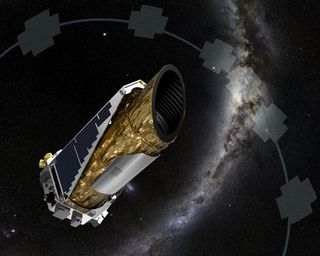
The mystery behind a strangely dimming star could soon be solved.
Astronomers around the world are keeping a close eye on the star KIC 8462852, which has dimmed dramatically numerous times over the past few years, dropping in brightness by up to 22 percent. These big dips have spurred speculation that the star may be surrounded by some type of alien megastructure — a hypothesis that will be put to the test if and when KIC 8462852 dims again.
"As long as one of those events occurs again, we should be able to catch it in the act, and then we'll definitely be able to figure out what we're seeing," said Jason Wright, an astronomer at Pennsylvania State University. [13 Ways to Hunt Intelligent Alien Life]
KIC 8462852 is a large star that lies about 1,500 light-years from Earth. The dimming events, which were observed by NASA's Kepler space telescope between 2009 and 2013, seem too substantial to be caused by an orbiting planet, many astronomers say.
Another plausible explanation — a planet-forming disk — doesn't seem to make sense, either, because KIC 8462852 appears to be a mature star whose planets (if it has any) have already formed.
So scientists are entertaining a number of other ideas, hypothesizing that the dimming might be caused by a swarm of exocomets or perhaps even some type of orbiting alien megastructure. This latter possibility is unlikely, researchers stress, but it's still worth checking out. Indeed, astronomers have aimed radio telescopes at KIC 8462852 to search for signals that may have been generated by intelligent aliens.
And follow-up is proceeding on other fronts as well. A number of optical telescopes are watching the star, waiting for another multiday dimming event to take place. Once such an event begins, large scopes outfitted with spectrographs will swing into action, studying and monitoring the various wavelengths of light emanating from KIC 8462852, Wright said.
Get the Space.com Newsletter
Breaking space news, the latest updates on rocket launches, skywatching events and more!
"That'll tell us what that material is that the starlight is being filtered through," he said. "It'll tell us if maybe we're looking at ordinary astrophysical dust; it'll tell us if we're looking at gas."
"If we see any color dependence in the dimming — if it gets dimmer in the ultraviolet than it does in the infrared, for instance — then that would rule out that whatever we're looking at is a solid object," Wright added.
Wright thinks the data will eventually show that KIC 8462852's dimming events are caused by dust. If that turns out to be the case, it would raise another mystery for astronomers to solve — namely, where all that dust is coming from. Is it being shed by exocomets, for example, or is the material trapped in a giant ring system around a Saturn-like alien planet?
"The amount of dimming we get tells us something about the size of the dust — is it as fine as smoke, or is it pebbles and things?" Wright said. "That'll help us figure out which of those scenarios we're looking at."
Follow Mike Wall on Twitter @michaeldwall and Google+. Follow us @Spacedotcom, Facebook or Google+. Originally published on Space.com.
Join our Space Forums to keep talking space on the latest missions, night sky and more! And if you have a news tip, correction or comment, let us know at: community@space.com.

Michael Wall is a Senior Space Writer with Space.com and joined the team in 2010. He primarily covers exoplanets, spaceflight and military space, but has been known to dabble in the space art beat. His book about the search for alien life, "Out There," was published on Nov. 13, 2018. Before becoming a science writer, Michael worked as a herpetologist and wildlife biologist. He has a Ph.D. in evolutionary biology from the University of Sydney, Australia, a bachelor's degree from the University of Arizona, and a graduate certificate in science writing from the University of California, Santa Cruz. To find out what his latest project is, you can follow Michael on Twitter.
